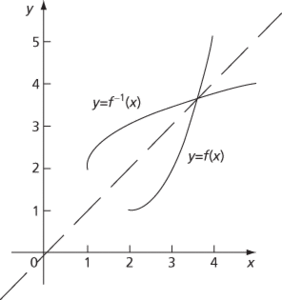For a function f, its inverse function f−1 (or just inverse) is to be a function such that y = f(x) if and only if x = f−1(y). If such a function exists, then it is unique and f is said to be invertible. Suppose that f has domain S and codomain T. To be invertible f: S → T needs to be onto so that every y in T equals f(x) for some x in S. However, any inverse f−1, with domain T and codomain S must uniquely assign such x to this y and so f must also be one‐to‐one. The inverse is then defined by: for y in T, f−1(y) is the unique element x of S such that f(x) = y. Consequently, f is invertible if and only if it is a bijection.
For a real function defined on an interval I, if f is strictly increasing on I or strictly decreasing on I, then f is one‐to‐one and so bijective onto its image.
When an inverse is required for a given function f, it may be necessary to restrict the domain and obtain instead the inverse function of this restriction of f. For example, suppose that f: ℝ → ℝ is defined by f(x) = x2−4x + 5. This function is not one‐to‐one but is strictly increasing for x≥2. Use f now to denote the function defined by f(x) = x2−4x + 5 with domain [2, ∞). The image is [1, ∞) and the function f :[2,∞)→ [1,∞) has inverse f−1: [1,∞)→ [2,∞). A formula for f−1 can be found by setting y = x2−4x + 5 and, remembering that x∈[2,∞), obtaining So, with a change of notation, for x≥1.

The graph of a function and its inverse
When the inverse function exists, the graphs y = f(x) and y = f−1(x) are reflections of each other in the line y = x. See inverse function theorem, inverse hyperbolic function, inverse trigonometric function, left inverse, right inverse.
A function, usually written f-1, that reverses the effect of another given function f. If f(x) = y, then f-1(y) = x. The inverse of a function is only well-defined if the function is bijective, meaning that it maps different inputs to different outputs. The inverse of f-1 is f itself.
- marker bed
- marker gene
- market
- marketable security
- market access
- market capitalization
- market clearing
- market conduct
- market cycle
- market definition
- market economy
- market entry
- market equilibrium
- market failure
- market forces
- market for lemons
- market fundamentalism
- marketing
- market-maker
- market mechanism
- market potential
- market power
- market prices
- market risk
- markets